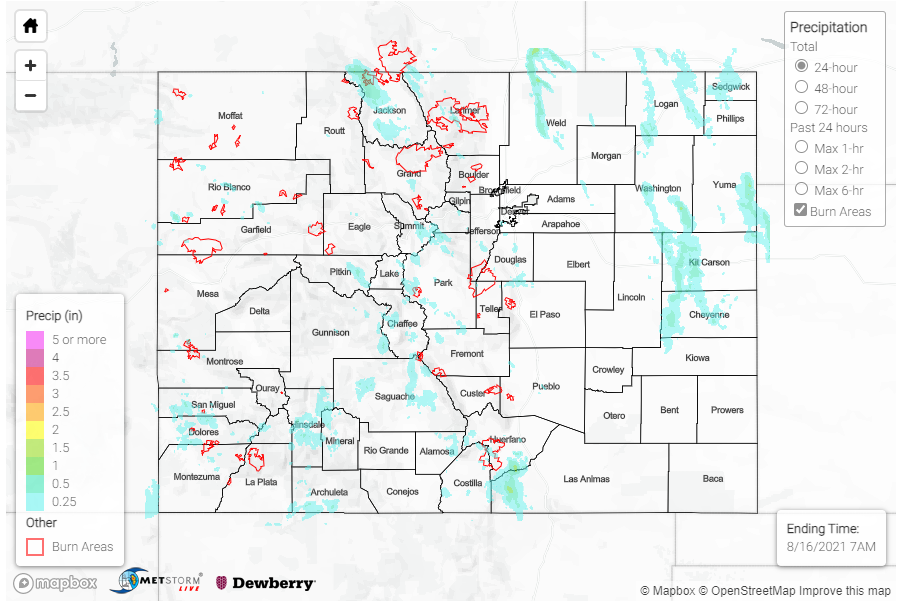Issue Date: Sunday, August 15th, 2021
Issue Time: 9:25 AM MDT
Summary:
Saturday morning started with clear skies across much of the state and improved smoke conditions after a long string of days with poor air quality and haze. As the day progressed, isolated showers and storms began to fire in the high elevations, especially in the Northern and Central mountains. As afternoon turned to evening, storms filled in and became more widespread and organized in high elevations of the San Juan, Southeast, and Front Range Mountains, as well as spilling into the Southwest Slope and Northeast Plains as storms rotated around the high pressure traversing the state from west to east.
During all the action, the Cameron Peak (Northern and Front Range Mountains) and Spring Peak (Southeast Mountains) burn scars had flash flood warnings issued after Doppler radar indicated heavy rainfall. Portions of each scar received heavy rainfall, up to 0.5 inches, but thankfully no flooding was reported to have occurred at either burn scar.
By night, storms were moving southeast along the Urban Corridor and Northeast Plains. Much of the Denver metro area received light precipitation, and a cell between Castle Rock and Colorado Springs dropped up to 0.5 inches of rain. Linear storms on the northeast plains were strong enough for severe thunderstorms warnings along the Wyoming and Nebraska borders. An 0.88 inch hail report was made in Sedgewick by a CoCoRaHS observer, as well as many high wind reports along the Plains. Areas impacted by storms in the Northeast Plains received between 0.10 – 0.48 inches of rain as well.
Flooding was not reported on Saturday. For rainfall estimates in your area, check out the State Precipitation Map below.
Click Here For Map Overview
The map below shows radar-estimated, rainfall gage-adjusted Quantitative Precipitation Estimates (QPE) across Colorado. The map is updated daily during the operational season (May 1 – Sep 30) by 11AM. The following six layers are currently available: 24-hour, 48-hour and 72-hour total precipitation, as well as maximum 1-hour, 2-hour and 6-hour precipitation over the past 24 hour period (to estimate where flash flooding may have occurred). The accumulation ending time is 7AM of the date shown in the bottom right corner. Also shown optionally are vulnerable fire burn areas (post 2012), which are updated throughout the season to include new, vulnerable burn areas. The home button in the top left corner resets the map to the original zoom.
